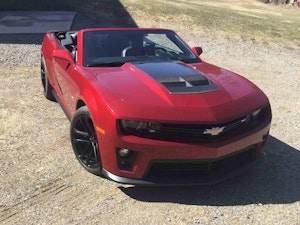Media | Articles
Why you shouldn’t write off the first-generation Corvette
When the first Corvette debuted in New York City at the GM Motorama on January 17, 1953, the public fell head-over-heels for its beauty. The broad, sleek fiberglass body exuded confidence, and the overall design was more robust than other popular sports cars of its time, such as the Triumph TR2 and Austin-Healey 100. The car was fast, stylish, and exceptionally American.
Based on the overwhelming praise from the public, Chevrolet ordered the Corvette into production, and the first-ever Chevrolet sports car rolled off the assembly line on June 30, 1953. Just 300 examples were built that year, each one painted Polo White with a red interior.
Though enthusiasts sensationalized ’53 and ’54 Corvettes for their aesthetics, performance technology was nothing to shake a stick at. The engine was a slightly-updated 150-horsepower Stovebolt inline-six, which, however bulletproof, had been in production since 1941. A simple two-speed automatic transmission put the power to the pavement, and the suspension was taken from existing Chevy sedans. It was apparent that Chevrolet needed more time to refine the Corvette, but despite its early drawbacks, the first generation of ’Vettes gained an immediate fan base and soon became a darling of the 1950s.
A legend is born
Many enthusiasts agree that the Corvette didn’t become a genuine sports car legend until a V-8 lived under its hood. The 1955 Corvette was somewhat deceiving at first glance. The body and chassis saw limited changes while Chevrolet focused integrating the car’s first-ever small-block V-8. Paired with the three-speed manual transmission, the new 195-hp engine improved the Corvette’s 0–60 time from the original inline-six’s 11 seconds to 8.5 seconds. The much-needed performance upgrade likely saved sale numbers from flatlining. It’s not eye-watering by today’s standards, but the ’55 Corvette is the car that made fast Corvettes possible.
For 1956, the straight-six was dropped from the Corvette lineup completely, leaving only the 265-cubic-inch V-8 with a power range of 210–240 horsepower. Chevrolet also fitted the ’56 with a refined body, real glass windows that rolled up, and a substantially better convertible top that resolved previous leakage issues.
Marketplace
Buy and sell classics with confidence
More fuel, more horsepower
By 1957, consumers could easily order the Corvette with a V-8 and a four-speed transmission. Not only that—this is the year that the Rochester Ramjet fuel injection came in and upped the game. A year prior, a version of the injection system was installed in John Fitch’s ’56 Corvette SR and put to the test at Sebring, resulting in a B-Class win in the FIA World Sports Car Championship.
Of the 6338 Corvettes built for 1957, Chevrolet equipped just over 1000 with the Ramjet fuel injection system. The precise fuel distribution forced 283 hp out of the factory 283-cu-in small-block. Read that again: that’s 1 hp per cubic inch, an impressive spec for a time when most engines didn’t achieve half of that.
The highest power output available for the 1958, ’59 and ’60 Corvettes was 290 hp, fuel-injected, of course. The year 1958 also marked the beginning of the quad-headlamp era, which would vanish with the second-generation’s redesign. Chevrolet released what is arguably the most striking Corvette ever in 1961, a cross between the C1’s front end and the rear of the C2. More importantly, the Chevrolet upped the V-8’s cubes to 327 in the ’62 model year.
We’ll stop rambling and get to the point: The 1953 Chevrolet Corvette is often referred to as the most flawed Corvette ever produced, but we disagree. Its greatness lies in the fact that it is the very first of its breed, the car that started it all. Think about it for a moment: without the ’53, the Corvette wouldn’t exist. What kind of world would that be? Fortunately, we will never know.
Want to relive the glory of the Corvette’s first generation? Check out the selection of first-gen Vettes on DriveShare and rent one for a day—or a weekend!









20200114195958)
20200114200012)
20200114200020)
20200114200036)
20200114200043)
20200114200101)
20200114200124)
20200114200140)
20200114200151)
20200114200210)
20200114200228)
20200114200249)
20200114200308)
20200114200327)

